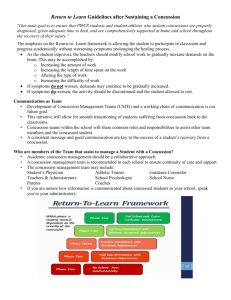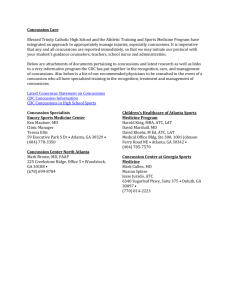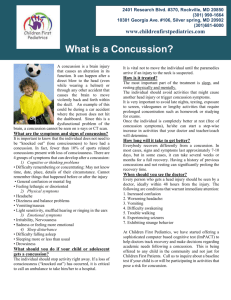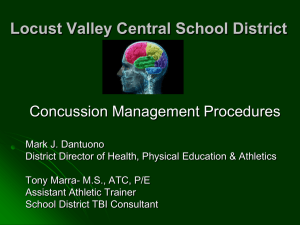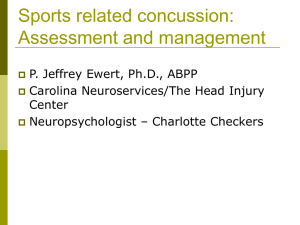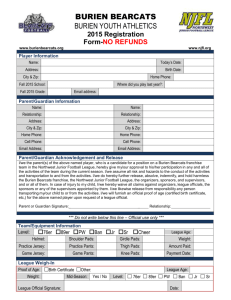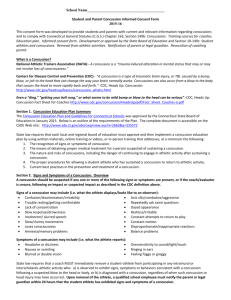PPL 1O - Concussion Awareness Student note
advertisement
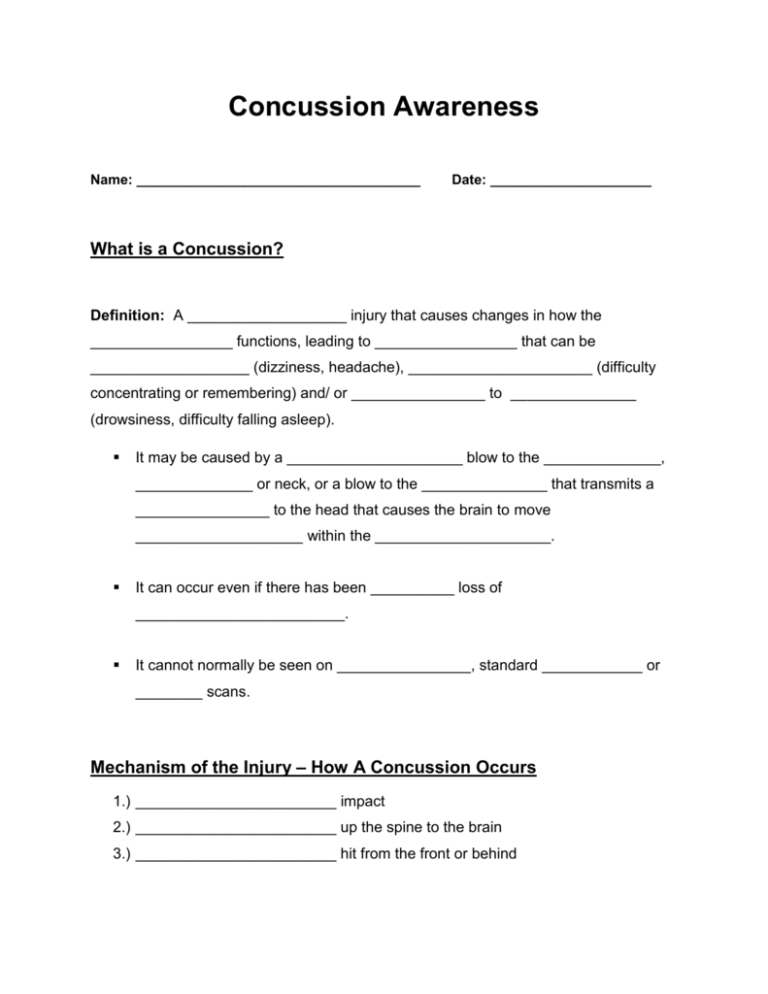
Concussion Awareness Name: _____________________________________ Date: _____________________ What is a Concussion? Definition: A ___________________ injury that causes changes in how the _________________ functions, leading to _________________ that can be ___________________ (dizziness, headache), ______________________ (difficulty concentrating or remembering) and/ or ________________ to _______________ (drowsiness, difficulty falling asleep). It may be caused by a _____________________ blow to the ______________, ______________ or neck, or a blow to the _______________ that transmits a ________________ to the head that causes the brain to move ____________________ within the _____________________. It can occur even if there has been __________ loss of _________________________. It cannot normally be seen on ________________, standard ____________ or ________ scans. Mechanism of the Injury – How A Concussion Occurs 1.) ________________________ impact 2.) ________________________ up the spine to the brain 3.) ________________________ hit from the front or behind Anatomy of the Brain Interesting Facts: ____________________________________________________________________________________ ____________________________________________________________________________________ ____________________________________________________________________________________ ____________________________________________________________________________________ ____________________________________________________________________________________ Signs & Symptoms of a Concussion Signs Observed by Others Symptoms Reported by Athlete Appears dazed or stunned Headache or “pressure” in head Confused about assignment/position Balance problems or dizziness Forgets sports plays Double or blurry vision Is unsure of game, score, or opponent Sensitivity to light Moves clumsily Sensitivity to noise Answers questions slowly Feeling sluggish, foggy, or groggy Loses consciousness (even briefly) Concentration or memory problems Shows behaviour/personality changes Confusion Can’t recall events prior or after hit Does not “feel right” Source: CDC Where can I go for help? 1. _____________________________ 2. _____________________________ 3. _____________________________ 4. _____________________________ Recovery Times These are based for the first concussion an Individual receives: • Most Adults – ____________________ days. • University students – ___________ days. • High School students – _________________ days. (5 – 15% may experience persistent symptoms for _______ months) Video - Dr. Mike Evans: Concussion management and return to learn Highlights / Thoughts of the Video – Chronic Traumatic Encephalopathy (CTE) • Repetitive concussions ___________ lead to brain degeneration (CTE). • CTE occurs later in life leading to: - B_________________ and c_________________ deficits - P________________’s Disease, D______________, E____________, - A__________________________, A_________ (Lou Gehrigs Disease), - Deep D____________________, destructive b__________________, - S___________________, h______________________ The increase in TAU Protein from multiple concussions destroys neural pathways. It is a biochemical injury where upon the chemical transfer from one cell to another is altered. Second Impact Syndrome • If the concussion is not fully __________________ and a second ______________ occurs the signs and symptoms will worsen. • The Concussion will take __________________ to heal. • D_____________ could occur. Video: Keeping Quiet Can Keep You Out of the Game Highlights / Thoughts of the Video – Return to Learn: 6 Steps There is a six-step process to follow: Step 1 – ________________________________________ Step 2 – Gradual reintroduction _______________________________ Step 3 – Homework at _____________ before school work at ______________ Step 4 – ________________________________________ Step 5 – Gradual re-integration ___________________________________ Step 6 – Resumption of full _______________________________________ Return to Physical Activity Returning to normal activities, including sport participation, is a step-wise process that requires p___________________, a_____________________, and caution. The athlete must be s____________________ free for a m___________________ of ________ hours before progressing to the next step There is a _______ step process to follow: Step 1: No ______________________, only complete rest. Objective – R________________________. Step 2: Light _________________________ exercise. Objective - ________________________ Heart Rate (HR) - 70 % of maximum heart rate (220 - age x 0.70) Step 3: Sport ___________________________ activities. No contact (running drills) Objective – Add _____________________________. Step 4: More complex _____________ without ____________ contact (Full Practice) Objective – E_________________, C__________________, & Cognitive load. Step 5: Begin drills with ________________ contact. Objective – Restore confidence and assess functional skills by coaching staff. Step 6: Game play. Objective – Full return to pre-injury activities / Normal Game play Summary of the most important facts: • A concussion is a clinical diagnosis, since there is a judgment call based on reported symptoms there may be room for error. • It cannot be seen on a CT scan or MRI. • No proven treatments...no drug or therapy is available to speed up the recovery. • A concussion aggravates existing conditions. • Females may be more predisposed to concussions. • There may also be a genetic link to concussion. • The recovery time is different for everyone. • The effects of a concussion, such as the inability to maintain attention and focus, can last from six months to a year in teenagers. • The adolescent brain is the most susceptible to damage and takes the longest to recover. • Post concussion syndrome can become apparent years later. • Repetitive concussions lead to brain degeneration (CTE). • Mouth guards or helmets do not prevent concussions.




